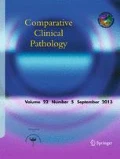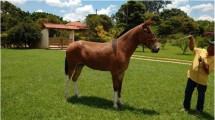Abstract
In order to study the serum biochemistry of Iranian Turkmen horses, we conducted sampling from 48 clinically normal horses aged between 1.5 and 12 years, and the following results were obtained: albumin (Alb) 43.95±4.48 g/l; total protein (Tp) 73.58±6.1 g/l; globulin (Glo) 2.81±0.65 g/l; A:G 1.66±0.46; glucose (Glu) 4.92±0.63 mmol/l; triglyceride (Tri) 0.26±0.1 mmol/l; cholesterol (Cho) 2.44±0.43 mmol/l; urea (Ure) 6.2±0.98 mmol/l; creatinine (Cre) 119.34±19.45 μmol/l; bilirubin (Bili) 16.07±7.01 μmol/l; aspartate aminotransferase (AST) 269.81±74.40 IU/l; alanine aminotransferase (ALT) 9.92±2.9 IU/l; alkaline phosphatase (AP) 422.7±110.37 IU/l; sodium (Na) 143.75±7.26 mmol/l; potassium (K) 3.84±0.46 mmol/l; chloride (Cl) 89.55±4.17 mmol/l; calcium (Ca) 2.85±0.15 mmol/l; phosphorus (P) 1.16±0.16 mmol/l; magnesium (Mg) 0.81±0.11 mmol/l; iron (Fe) 23.97±7.48 μmol/l. Between age groups, ALT, bilirubin, phosphorus and iron levels showed significant differences, with higher levels in horses aged 3–5 years, >5 years, <3 years and >5 years, respectively (P<0.05). Creatinine was the only parameter that showed significant difference between the genders, with male horses having higher values than female (P<0.05). Marginal difference was also seen between genders for bilirubin levels (P=0.052). Correlations between measured parameters were also determined.
Similar content being viewed by others
References
Atyabi N, Pourkabireh M, Nowrouzian I, Mojabi A, Nadalian MG, Khazrainia P (2001) A survey for blood serum protein of the Caspian miniature horse and comparison with that of the Iranian Arab horse. Scientific and Research Quarterly of the Iranian Ministry of Agriculture (Pajouhesh-Va-Sazandegi) (in Farsi with English abstract). 13:124–126
Bahari AA, Rahi H, Chalechaleh AA, Pourkabireh M (2001) Reference ranges for some enzymes and electrolytes of serum in Kurd horses. Scientific and Research Quarterly of the Iranian Ministry of Agriculture (Pajouhesh-Va-Sazandegi) (in Farsi with English abstract) 14:72–75
Benjamin MM (1978) Outline of veterinary clinical pathology, 3rd edn. Iowa State University Press, Ames
Draper J (1996) The book of horses and horse care, 2nd edn. Smithmark, New York
Duncan JR, Prasse KW, Mahaffey EA (1994) Veterinary Laboratory Medicine: Clinical Pathology, 3rd edn. Iowa State University Press, Ames
Eades SC, Bounous DI (1997) Laboratory profile of equine diseases. Mosby Year Book, Saint Louis
Edwards EH (1985) Encyclopaedia of the horse, 2nd edn. Peerage Books, London
Finco DR (1989) Kidney function. In: Kaneko JJ (ed) Clinical biochemistry of domestic animals, 4th edn. Academic Press, San Diego, p 528
Hendricks BL (1995) International encyclopedia of horse breeds. University of Oklahoma Press, Oklahoma City
Kaneko JJ (1989) Clinical biochemistry of domestic animals (edn 4). Academic Press, San Diego
Katoch A, Katoch S, Gupta K, Dogra PK, Sharma SK, Thakur YP (2003) Minerals and biochemical profiles in Spiti horses. Centaur 20:48–49
Meyer DJ, Harvey JW (1998) Veterinary laboratory medicine: interpretation and diagnosis, 2nd edn. Saunders, Philadelphia, pp 201, 346
Nazifi S, Saeb M, Khoshvaghti A (2003) Studies on the relationship between haemoglobin types of adult Turkman horses and the concentrations of haemoglobin, copper, ceruloplasmin and iron. Comp Clin Pathol 12:53–56
Author information
Authors and Affiliations
Corresponding author
Rights and permissions
About this article
Cite this article
Mohri, M., Sardari, K. & Farzaneh, N. Serum biochemistry of Iranian Turkmen (Akhal-Teke) horses. Comp Clin Path 13, 128–131 (2005). https://doi.org/10.1007/s00580-004-0527-1
Received:
Accepted:
Published:
Issue Date:
DOI: https://doi.org/10.1007/s00580-004-0527-1



